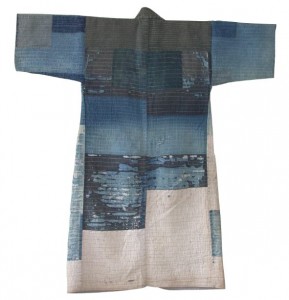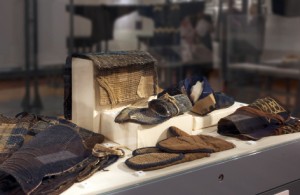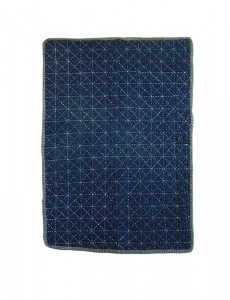
This article has originally been published in the online version of the HandEye magazine, and is republished with permission.
Japan’s Edo period was an austere period in more than one sense: Under the lead of the Tokugawa shogunate the country had virtually closed itself off from all neighbours and trading contacts. Only a small selection of valued high quality goods reached the country through the Dutch trade enclave on the tiny artificial island of Dejima just off Nagasaki. Most of the goods were destined for the court of the shoguns in Tokyo. The country was required to be completely self-sufficient in all aspects of live, and skills to ‘make do and mend’ evolved from pure survival into something akin to an art form and way of live.
While the samurai class took pride in their women being accomplished spinners, dyers, weavers and seamstresses, the middle class townspeople made abundant use of a large number of second hand clothing dealers. Far beyond only buying and reselling clothes, these dealers would buy used clothing, take them apart, re-dye them, sew them back together again – even mixing parts of different garments – and eventually sell them on. In the country side however, and among the working class in the cities, clothinga was a luxury that had but a single purpose: protect the wearer from the weather and the impact of their labour onto the body.
Strictly enforced national laws regulated who could wear what type of fabric and colours, and although cotton was cultivated from the 16th century onwards, the farmers were not allowed, nor could they afford, to wear cotton clothes themselves. The fibre of choice for clothing were bast fibres (Asa) such as ramie, nettles and Japanese hemp. Once woven, the cloth was then dyed with blue indigo, which is hard wearing, was believed to repel insects and snakes, and therefore judged perfectly suitable for the labour these communities engaged in.
It is from the working class and remote communities that the plain-stitch embroidery quilting technique sashiko (from ‘sasu’, to pierce) originated: to protect, or mend, clothing and fabric. The basic technique is a small running stitch that follows the grain of the fabric, whereby horizontal rows of stitches are considered stronger than vertical rows. And while the geometric patterns of white stitching contrasted prominently with the indigo coloured ground, sashiko was initially used for mere practical reasons: By doubling up layers and stitching them together, or by recycling old pieces of cloth into a new garment, the finished product naturally became more durable and, equally important, warmer.
The women in working class and rural households – responsible for all domestic as well as most agricultural duties – progressively converted a mere necessity into a display of their skill and achievements as a wife and mother, and a public testimony for their contribution to the household. Sashiko was a skill learned at a young age, and the needlework would be considered an important indicator as to a girl’s credibility for marriage at a time and age when marriages were arranged.


– Designs placed around the hem of a garment, its sleeve openings and the neckline were believed to prevented evil spirits from entering the human body.
– Kimonos for babies had stitching applied to the back neckline as a talisman and to safeguard a vulnerable area.
– Vulnerable parts of the body were protected by small stitched symbols hidden in the inside of the garment.
– The cross over of stitches, called ‘me’ (目) in Japanese and meaning ‘eye’ in English, were believed to have strong protective powers. Some patterns had thousands of cross over stitches.
Sashiko clothing was worn by all members of working class society and never got to be considered fashionable as a result of the low social status of the communities it originated from. But what started off as a technique to make clothing more durable and suited to the tasks they were worn for, evolved into an expert craft even used for purely decorative purposes as can be seen in Kesa garments of Buddhist priests or the Kogin from the northern parts of Honshu.
While stitched protective symbols are on occasions still found in modern, western-style garments ‘made in Japan’, the days when sashiko garments were sewn with a practical purpose in mind are long gone. The technique is now only used to embellish single layered fabrics for varying purposes, and only a handful of elderly women, well into their 80s and 90s, still can recall the times when sashiko was a firm part of the culture of Japan’s working class.

